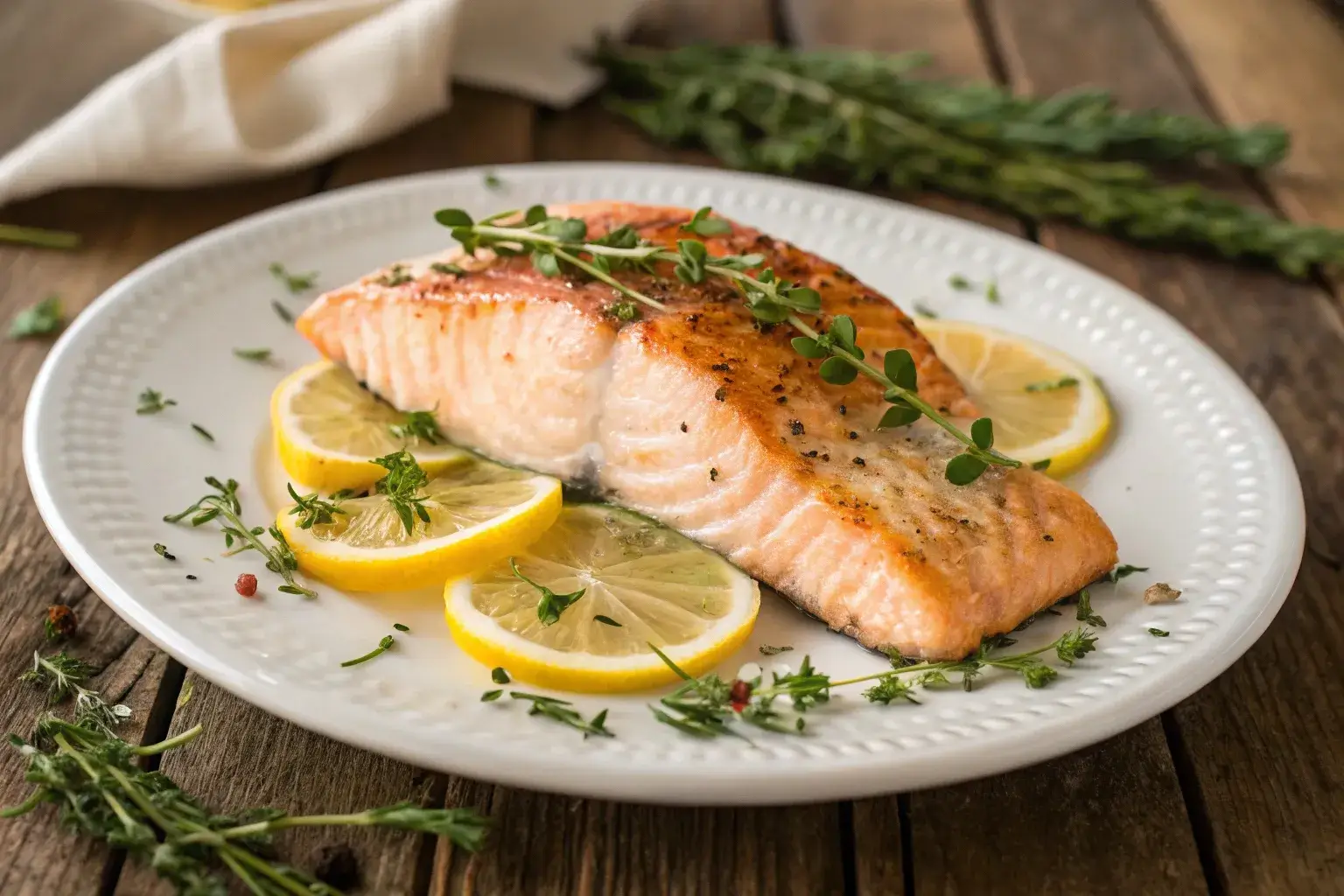Ever tried baking salmon and ended up with a dry, flavorless fillet? It’s frustrating, isn’t it? The secret to success lies in knowing exactly how long to bake salmon at 350. This sweet spot ensures your salmon turns out tender, moist, and absolutely delicious. In this blog, we’ll dive into everything you need to know from timing based on fillet thickness to foolproof tips for keeping your salmon juicy. Plus, we’ll share easy seasoning ideas that’ll have you craving seconds. Whether you’re a beginner or a seasoned home chef, this guide is your ultimate ticket to baked salmon perfection. So, let’s get started—because great meals begin with just a little know-how!
How Long to Bake Salmon at 350: Mastering the Basics
Factors That Affect Baking Time
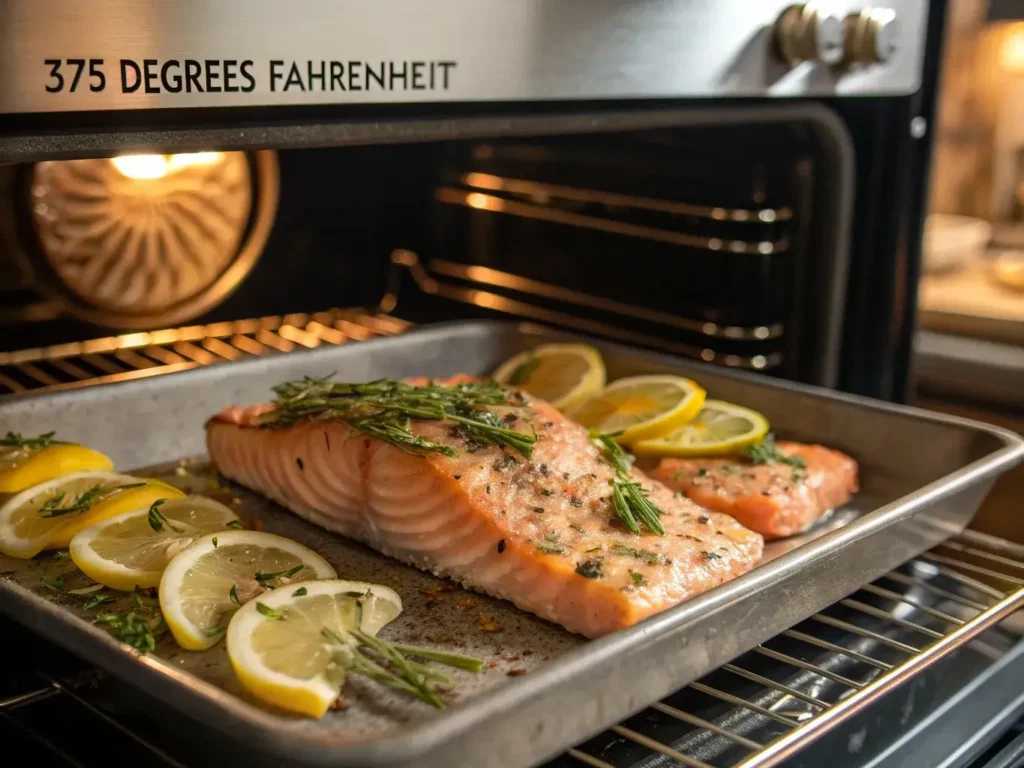
The question how long to bake salmon at 350 depends on a few key factors. First, the thickness of the fillet plays a crucial role. Thinner fillets (about 1 inch thick) bake in 12-15 minutes, while thicker cuts (over 1 inch) may require 15-20 minutes. Additionally, whether your salmon is fresh or frozen matters. Frozen salmon typically takes a few minutes longer unless it’s thawed beforehand.
Another factor is how you prepare the fish. Wrapping the salmon in foil or parchment paper not only locks in moisture but can also slightly reduce baking time. On the other hand, unwrapped salmon bakes evenly but may dry out faster. By understanding these factors, you can adjust your timing for perfect results every time.
Recommended Baking Times by Salmon Thickness
To achieve perfectly baked salmon, it’s essential to match the baking time to the thickness of your fillet. Here’s a quick guide:
- Thin fillets (1 inch or less): Bake for 12-15 minutes at 350°F.
- Thick fillets (over 1 inch): Bake for 15-20 minutes at the same temperature.
For best results, check the internal temperature at the thickest part of the fillet. When the salmon reaches 145°F (63°C), it’s ready to enjoy. If you don’t have a thermometer, look for the flesh to flake easily with a fork—a sure sign it’s done.
Need more guidance? This detailed salmon baking guide offers additional tips for achieving a flawless bake.
The Benefits of Using Foil or Parchment Paper
Wrapping your salmon in foil or parchment paper can make a world of difference. This method traps steam as the fish cooks, which keeps it moist and tender. Additionally, using foil eliminates the need for oiling the baking sheet and makes cleanup effortless.
Foil-baked salmon also cooks more evenly, especially when paired with seasoning or marinade. Simply wrap the fish with lemon slices, garlic, and your favorite herbs for a flavorful, no-fuss meal. While foil is excellent for retaining moisture, leaving the salmon uncovered in the oven can create a slightly crispier texture on top. Therefore, choose your method based on your preference for tenderness or crispiness.
How to Check for Doneness
Knowing how long to bake salmon at 350 is important, but ensuring it’s cooked perfectly is just as crucial. To avoid overcooking, use a digital meat thermometer to check the internal temperature. When it hits 145°F, the salmon is safe to eat and beautifully flaky.
If you don’t have a thermometer, rely on visual and textural cues. The salmon should appear opaque throughout and separate easily into flakes with a fork. Additionally, the edges may have a slightly golden hue, while the center remains moist and vibrant in color. Keeping an eye on these signs ensures your salmon isn’t undercooked or dry.
Tips for Keeping Salmon Juicy While Baking at 350°F
Choosing High-Quality, Fresh Salmon
When baking salmon, freshness is crucial. High-quality salmon not only enhances the flavor but also helps keep it juicy. Look for salmon fillets that are bright in color, firm to the touch, and have no fishy odor. Wild-caught salmon, such as sockeye or coho, is a great choice for its rich flavor. If fresh salmon isn’t available, frozen fillets can be just as delicious just ensure they’re thawed completely before cooking to achieve even results.
Marinating to Lock in Moisture and Flavor
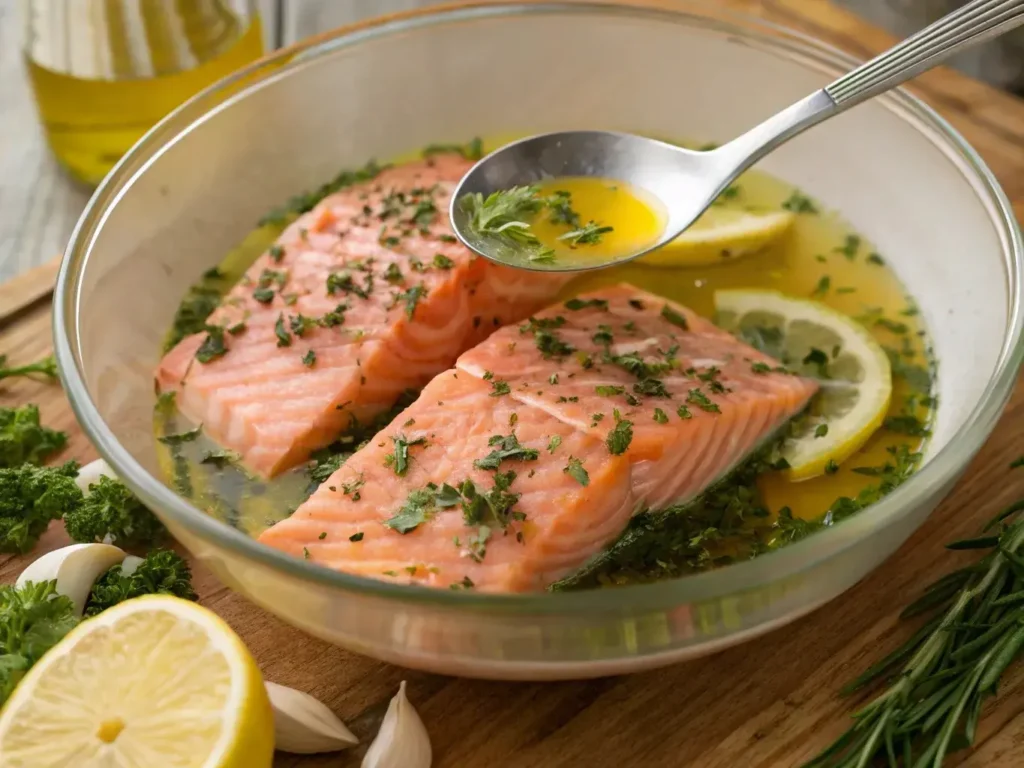
A good marinade can take your baked salmon to the next level. A mix of olive oil, lemon juice, garlic, and herbs adds flavor while keeping the fish tender. Coat the fillets and let them sit for at least 30 minutes before baking. Marinades not only enhance taste but also help retain moisture as the salmon cooks. For more inspiration, check out this guide to marinades that pairs well with seafood.
Using the Right Baking Method
The baking method you choose can make all the difference in maintaining moisture. Wrapping the salmon in foil or parchment paper creates a steam pocket, locking in juices as it bakes. On the other hand, baking without a cover results in a slightly crispier texture but requires careful monitoring to avoid drying out. Whichever method you prefer, always preheat the oven to ensure even cooking.
Avoiding Common Mistakes
To keep your salmon juicy, avoid overcooking. Since the answer to how long to bake salmon at 350 depends on the thickness, use a meat thermometer to check the internal temperature. Aim for 145°F at the thickest part. Another mistake to avoid is skipping the resting step—letting the salmon rest for a few minutes before serving allows the juices to redistribute, enhancing its tenderness.
Enhancing the Flavor of Salmon When Baking at 350°F
Using Simple Seasonings to Elevate Taste
Sometimes, simplicity is key when baking salmon. A sprinkle of salt, freshly cracked black pepper, and a drizzle of olive oil can enhance the fish’s natural flavor. If you’re wondering how long to bake salmon at 350 with minimal seasoning, rest assured the time doesn’t change. Just ensure you evenly coat the fillets to lock in moisture and flavor. Add a squeeze of lemon juice before serving for a refreshing finish.
For those who enjoy experimenting, garlic powder, paprika, and dill are excellent additions to bring out the salmon’s rich taste. These pantry staples are both flavorful and budget-friendly, making them ideal for quick, everyday meals.
Experimenting with Marinades and Glazes
To take your baked salmon up a notch, consider marinades or glazes. For example, a honey and soy glaze combines sweetness and umami, creating a caramelized finish as the salmon bakes. The baking time remains the same—how long to bake salmon at 350 depends on the thickness of the fish, not the seasoning method. Brush the glaze onto the fillets about halfway through baking for best results.
Want something zesty? A marinade of lime juice, olive oil, minced garlic, and chili flakes adds a spicy twist to your salmon. Let the fillets soak for 30 minutes before baking to maximize the flavor infusion.
Adding Vegetables and Herbs for a Full Meal
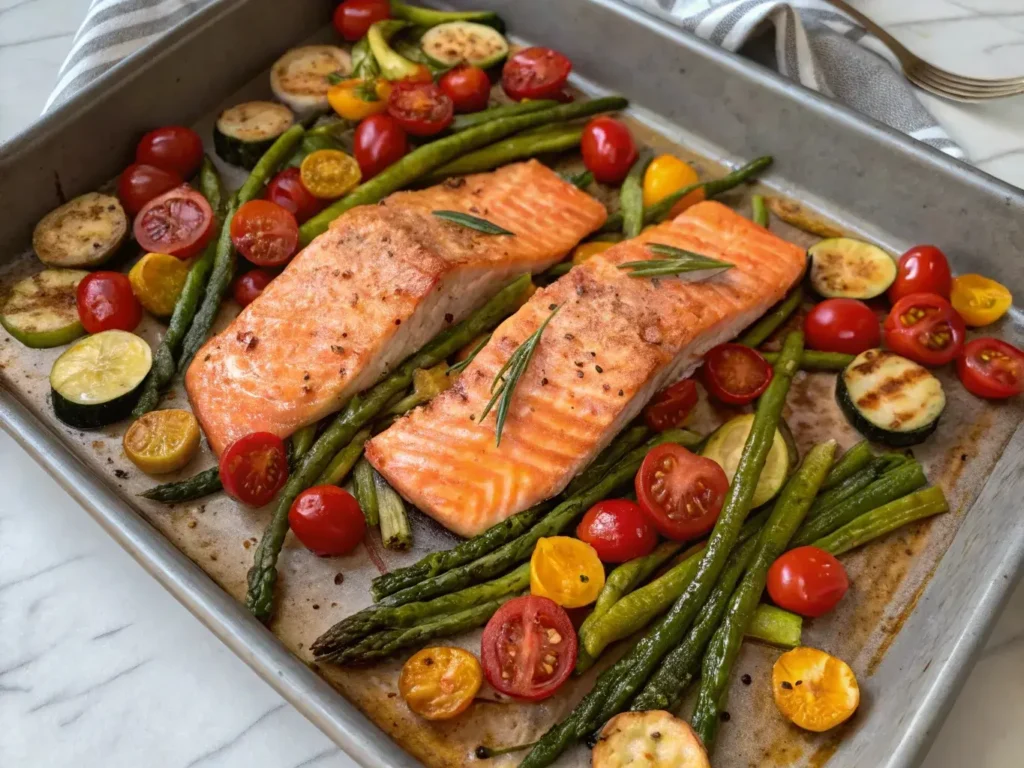
Pairing salmon with vegetables and herbs on the same baking sheet creates a convenient, one-pan meal. Vegetables like asparagus, zucchini, or cherry tomatoes cook beautifully alongside salmon. However, it’s important to cut the vegetables into smaller pieces so they cook evenly within the same timeframe as the fish. Adding rosemary or thyme sprigs enhances the aroma while complementing the salmon’s taste.
If you’re curious about how long to bake salmon at 350 when paired with veggies, stick to the standard 15-20 minutes for thicker fillets. The vegetables will roast to tender perfection by the time your salmon is done.
Incorporating Global Flavors into Your Baked Salmon
Baking salmon at 350°F doesn’t mean sticking to traditional seasonings. For a Mediterranean flair, season your fillets with oregano, lemon zest, and a drizzle of olive oil. Alternatively, an Asian-inspired soy-ginger marinade can deliver bold flavors with minimal effort.
Curious about unique spice blends? Try using Cajun seasoning for a smoky kick or a mix of cumin and turmeric for an earthy, aromatic profile. The baking time remains consistent, so how long to bake salmon at 350 won’t change even as you explore new culinary horizons.
Pro Tip: For more creative ways to cook with fish, check out our shrimp garlic recipe without butter for a delightful seafood variation.
Avoiding Common Mistakes When Baking Salmon at 350°F
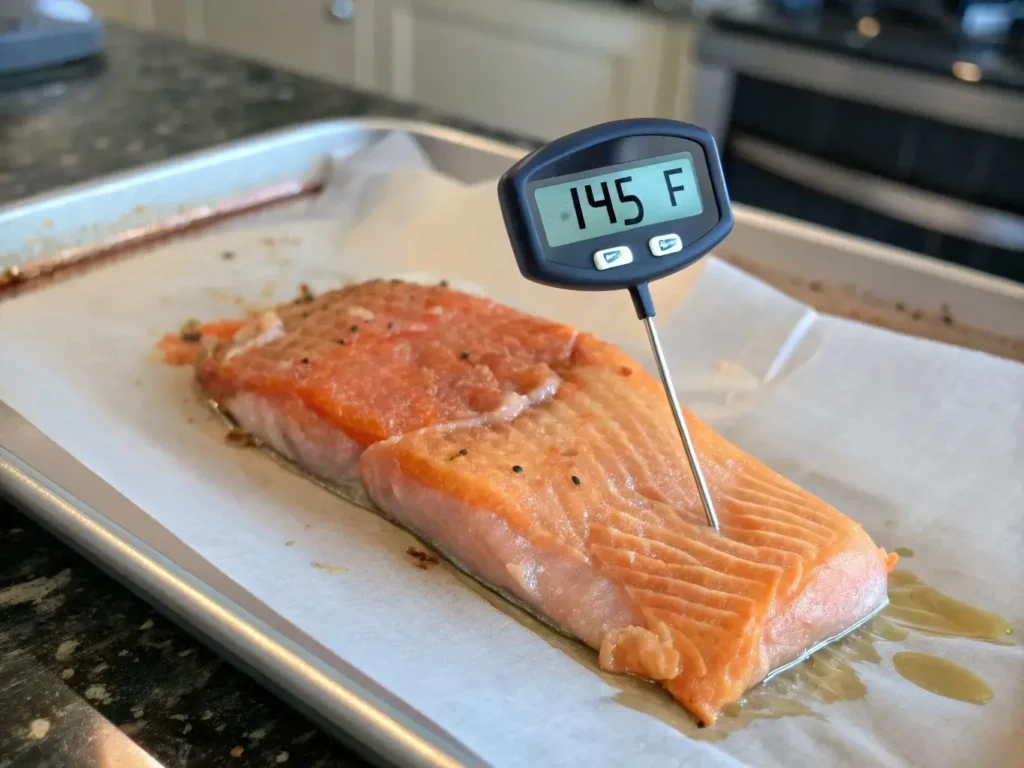
Overcooking the Salmon
One of the most common errors when baking salmon is overcooking it. This mistake can turn a moist, flavorful dish into a dry and tough disappointment. To prevent this, always stick to the recommended baking times. If you’re wondering how long to bake salmon at 350, remember that thinner fillets (1 inch or less) need only 12-15 minutes, while thicker cuts require 15-20 minutes.
Using a digital thermometer helps you monitor the internal temperature, which should reach 145°F at the thickest part of the fillet. Checking the salmon a few minutes before the estimated cooking time ensures you don’t accidentally overdo it.
Forgetting to Preheat the Oven
Skipping the preheating step is another mistake that can affect your salmon’s texture. Baking salmon in a cold oven leads to uneven cooking, with some areas potentially overcooked while others remain underdone. Always preheat your oven to 350°F before placing the salmon inside. This ensures consistent heat and reliable results every time.
In addition, using a preheated oven reduces the risk of the salmon drying out since it minimizes the time the fish spends in the oven.
Neglecting to Rest the Salmon After Baking
Resting salmon after it’s baked might seem unnecessary, but it’s a critical step for retaining juices. When salmon is pulled straight out of the oven, the juices are still in motion. Allowing the fish to rest for 3-5 minutes helps redistribute these juices, resulting in a more tender and flavorful bite.
This step is especially important if you’ve seasoned or marinated the salmon, as the resting period helps those flavors settle into the fish.
Using the Wrong Baking Dish
The type of dish you use can also impact how your salmon turns out. Baking salmon on a flat, rimmed baking sheet allows for even air circulation, ensuring uniform cooking. On the other hand, a deep dish can trap steam, which might make the salmon overly soft rather than flaky.
For foil or parchment-wrapped salmon, any baking tray works, but for uncovered fillets, a shallow pan is best to achieve a balance of moisture and slight crispiness. Adjust the cooking time slightly based on the type of dish, but the general guideline of how long to bake salmon at 350 still applies.
By avoiding these common mistakes, you can ensure that your baked salmon turns out perfectly every time. For additional inspiration and foolproof recipes, visit our Grilled Chicken Thigh Recipes Guide. This guide is packed with practical cooking tips you can use across a variety of dishes.
Frequently Asked Questions About Baking Salmon at 350°F
Is It Better to Bake Salmon at 375°F or 400°F?
Both 375°F and 400°F are popular choices for baking salmon, and each has its benefits. Baking at 375°F allows for slightly longer cooking times, usually around 10-12 minutes, which helps prevent overcooking while still achieving a tender texture. On the other hand, 400°F is ideal for those who prefer a crispier finish, as the salmon cooks faster, typically in 8-10 minutes.
However, if you’re looking for consistent results with juicy, evenly cooked fillets, baking at 350°F is a fantastic option. While it takes longer—12-20 minutes depending on the fillet’s thickness—it’s more forgiving and perfect for retaining moisture.
How Long Does It Take to Grill Salmon at 350 Degrees?
Grilling salmon at 350°F is a great way to infuse a smoky flavor while still cooking the fish evenly. On the grill, salmon fillets usually take 8-12 minutes, depending on their thickness. Be sure to flip the fillets halfway through to ensure both sides cook evenly.
Using a meat thermometer is highly recommended, as grilled salmon should reach an internal temperature of 145°F. While grilling is faster than baking, learning how long to bake salmon at 350 is essential if you prefer a more controlled and consistent cooking method.
What Is the Best Temperature and Time to Cook Salmon?
The best temperature and time for cooking salmon depend on your desired outcome. For tender, flaky salmon, baking at 350°F for 12-20 minutes is ideal. If you prefer a crispier texture, 375°F or 400°F can be used, but the baking time will be shorter—8-12 minutes depending on the fillet’s thickness.
Regardless of the temperature, always ensure the salmon’s internal temperature reaches 145°F for safe consumption. This allows for perfectly cooked fish that retains its natural juices and flavors. Mastering how long to bake salmon at 350 gives you a reliable method for consistently delicious results.
Is 15 Minutes Long Enough to Cook Salmon?
Yes, 15 minutes is often enough to cook salmon, especially thinner fillets. At 350°F, fillets less than 1 inch thick typically bake perfectly within 12-15 minutes. Thicker cuts may require closer to 20 minutes to ensure the fish is fully cooked.
To avoid undercooking or overcooking, always check the internal temperature of the salmon. When it reaches 145°F, the salmon is ready to serve. This ensures it’s both safe to eat and deliciously flaky.
Conclusion: Mastering How to Bake Salmon at 350°F
Learning how long to bake salmon at 350 is the key to creating perfectly cooked, juicy salmon every time. From understanding factors like fillet thickness to experimenting with marinades and seasonings, you now have the tools to elevate your salmon dishes. Baking at 350°F provides a balance of tender texture and even cooking, making it an excellent choice for both beginners and seasoned home cooks.
Whether you’re keeping it simple with salt and pepper or exploring bold global flavors, baking salmon is a versatile and foolproof method. Remember to preheat your oven, use a meat thermometer to check for doneness, and let the fish rest for a few minutes after baking to lock in moisture.
Now it’s your turn to put these tips into action! Gather your favorite seasonings, preheat to 350°F, and enjoy the satisfaction of serving perfectly baked salmon. For more inspiration, check out our quick and easy recipes to round out your meal.

